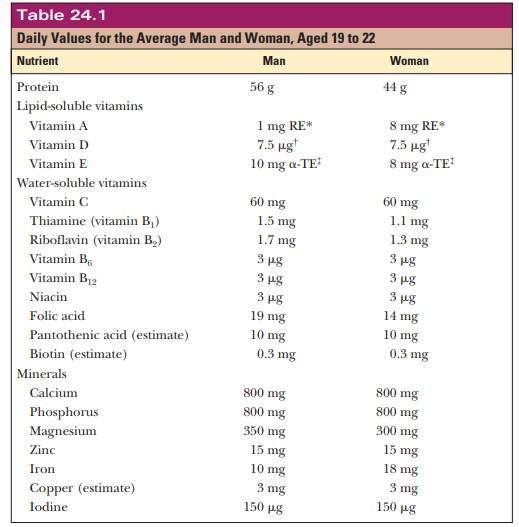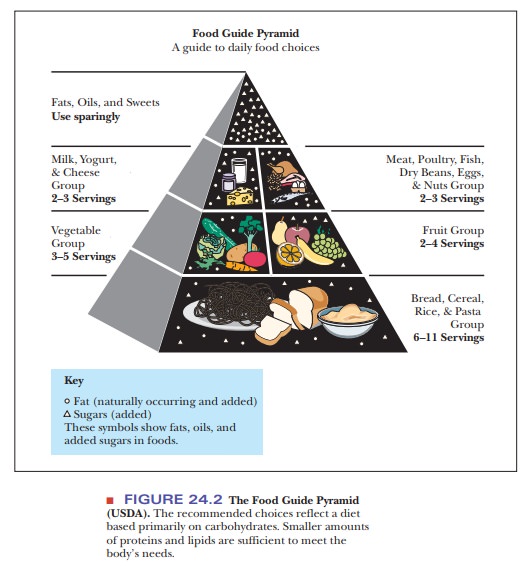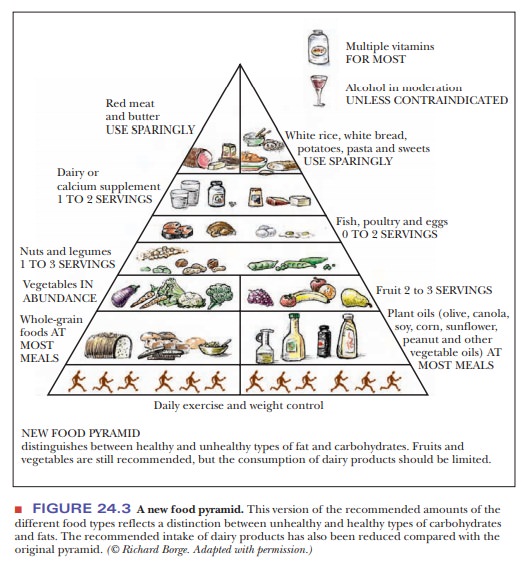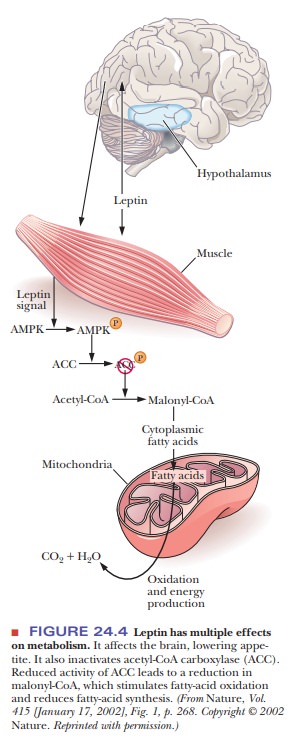Chapter: Biochemistry: Integration of Metabolism: Cellular Signaling
Biochemistry and Nutrition
Biochemistry and Nutrition
The molecules that we process by catabolic reactions ultimately
come from outside the body because we are heterotrophic organisms (dependent on
external food sources).
What are required nutrients?
In humans, the catabolism of macronutrients (carbohydrates, fats, and proteins) to supply energy is an important aspect of nutrition. In the United States, most diets provide more than an adequate number of nutritional calories. The typical American diet is high enough in fat that essential fatty acids are seldom, if ever, deficient. The only concern is that the diet contains an adequate supply of protein. If the intake of protein is sufficient, the supply of essential amino acids is normally also sufficient.
Packaging on food items frequently lists the protein content in terms of both the number of
grams of protein and the percentage of the daily value (DV) suggested by the
Food and Nutrition Board under the auspices of the National Research Council of
the National Academy of Sciences (see Table 24.1). Daily values have replaced
the recommended daily allowances (RDAs) formerly seen on food packaging.

There are some key biochemical concepts to remember when analyzing a diet for protein content. First, there is no storage form for proteins. This means that proteins eaten in excess do a person no good in terms of satisfying that person’s future protein requirements. All protein consumed in excess of what is needed is turned into carbohydrate or fat, and the nitrogen from the amino group must be eliminated through the urea cycle. Ingesting too much protein can therefore be stressful on the liver and kidneys because of the overproduction of ammonia that must be eliminated.
This is the
same risk faced by certain athletes who take creatine to build muscles, because
creatine is a highly nitrogenated compound.
Second, the essential amino acids must be consumed daily in order
for proteins to be made. It would be difficult to find a protein that did not
have at least one residue of each of the common 20 amino acids. Half of these
amino acids are essential, and if the diet is lacking or low in even one of
these essential amino acids, then protein synthesis is not possible. Not all
proteins are cre-ated equal. The protein efficiency ratio (PER) is an
indication of how complete a protein is. However, mixing proteins correctly is
very important, something that vegetarians know a lot about. A protein that is
very low in lysine would have a low PER value. If a second protein had a low
PER because it was low in tryptophan, it could be combined with the low-lysine
protein to give a combination with a high PER. However, this would work only if
the two were eaten together.
Third, proteins are always being degraded. Because of that, even if
a person does not seem to be doing any activities that would tend to require
protein replenishment, there is a constant need for quality protein in order to
maintain the body’s structures. Athletes are painfully aware of that fact. They
must train constantly, and they get out of shape quickly when they stop, the
effect being even more pronounced as the athlete reaches middle age.
Why do we need vitamins?
Micronutrients (vitamins
and minerals) are also listed on food packaging. Thevitamins we require are
compounds that are necessary for metabolic processes; either our bodies cannot
synthesize them, or they cannot synthesize them in amounts sufficient for our
needs. As a result, we must obtain vitamins from dietary sources. DVs are
listed for the fat-soluble vitamins—vitamins A, D, and E—but care must be taken
to avoid overdoses of these vitamins. Excesses can be toxic when large amounts
of fat-soluble vitamins accumulate in adipose tissue. Excess vitamin A is
especially toxic. With water-soluble vitamins, turnover is frequent enough that
the danger of excess is not normally a problem.
The water-soluble vitamins with listed DVs are vitamin C, which is
necessary for the prevention of scurvy, and the B vitamins—niacin, panto-thenic
acid, vitamin B6, riboflavin, thiamine, folic acid, biotin, and vitamin B12. The B
vitamins are the precursors of the metabolically important coenzymes listed in
Table 7.1, where references to the reactions in which the coenzymes play a role
are given. We have seen many pathways in which NADH, NADPH, FAD, TPP, biotin,
pyridoxal phosphate, and coenzyme A were found, all of which came from
vitamins. A summary of vitamins and their metabolic roles is given in Table
24.2. Frequently, the actual biochemical role is played by a metabolite of the
vitamin rather than by the vitamin itself, but this point does not affect the
dietary requirement.

What are minerals?
Minerals, in the nutritional sense, are inorganic substances required in theionic or free-element form for life processes. The macrominerals (those needed in the largest amounts) are sodium, potassium, chloride, magnesium, phosphorus, and calcium. The required amounts of all these minerals, except calcium, can easily be satisfied by a normal diet.
Deficiencies of calcium can, Calcium deficiencies can lead to bone
fragility, with concomitant risk of fracture, which is a problem especially for
elderly women. Calcium supplements are indicated in such cases. Requirements
for some microminerals (trace minerals) are not always clear. It is known, for
example, from biochemical evidence that chromium is necessary for glucose
metabolism (a role that has recently been suggested for chromium picolinate)
and that manganese is necessary for bone formation, but no deficiencies of
these elements have been recorded. Requirements have been established for iron,
copper, zinc, iodide, and fluoride; there are DVs for all of these minerals
except fluoride. In the case of copper and zinc, needs are easily met by
dietary sources, and overdoses can be toxic. A deficiency of iodide, leading to
an enlarged thyroid gland, has been a problem in some parts of the United
States for many years. Iodized salt is used to prevent this deficiency, and it
has become unusual to find table salt without an iodine supplement. Fluoride is
administered to prevent tooth decay in children and, with that end in mind, has
been added to water supplies, sometimes causing considerable controversy. Iron
is important because it is part of the structure of the ubiquitous heme
proteins. Women of childbearing age are more susceptible to iron deficiencies
than are other segments of the population, and in some cases supplements are
advised. These recommended levels vary with the age of the individual and are
subject to adjustment for level of activity.
The Food Pyramid
One approach to publicizing healthful food selection was the development of the Food Guide Pyramid, a graphic display that focuses on a diet sufficient in nutrients but without excesses (Figure 24.2). The goal was to use a well-chosen diet to promote good health. To avoid confusion, the development of this scheme had to take into account the fact that many people were familiar with the older recommendations about food groups.

The newer
recommendations pay particular attention to increasing the amount of fiber and
decreasing the amount of fat in the typical diet. Variety and moderation were
key concepts of the graphic presentation. From the biochemical point of view,
these recommendations translate into a diet based primarily on carbohydrates,
with enough protein to meet needs for essential amino acids. Note that in
Figure 24.2, carbohydrates are the base, with the correct amount suggested to
be 6 to 11 servings of foods rich in complex carbohydrates, such as bread,
cereal, rice, or pasta. Lipids should not contribute more than 30% of daily
calories, but the typical American diet currently is about 45% fat. High-fat
diets have been linked to heart disease and to some kinds of cancer, so the
recommendation about lipid intake is of considerable importance.
Is the old food pyramid still valid?
Many scientists are questioning some of the details of the food
pyramid. Certain types of fat are essential to health and actually reduce the
risk of heart disease. Also, there has been little evidence to back up the
claim that a high intake of carbohydrates is beneficial. Many people feel that
the original food pyramid, which was published in 1992, has serious flaws. It
overglorifies carbohydrates while making all fats out to be the bad guys. In
addition, meat, fish, poultry, and eggs are all lumped together as if they are
equivalent in terms of health. Plenty of evidence links saturated fat with high
cholesterol and risk of heart disease, but monounsaturated and polyunsaturated
fats have the opposite effect. Although many scientists knew the distinction
between the various types of fat, they felt that the average person would not
understand them, and so the original pyramid was designed to send the simple
message that fat was bad. The implied corollary to fat being bad was that
carbohydrates were good. However, after years of study, no evidence can be
shown that a diet that has 30% or fewer calories coming from fat is healthier
than one with a higher level.
To further complicate matters, we have to recall the effects of the
traveling forms of cholesterol—the lipoproteins. Having high levels of
cholesterol trav-eling as high-density lipoproteins (HDL) has been correlated
with a healthy heart, while having high levels of cholesterol traveling in the
form of low-density lipoproteins (LDL) is related to high risk of heart disease.
When calories from saturated fat are replaced by carbohydrates, the levels of
LDL and total cholesterol decrease, but so does the level of HDL. Because the
ratio of LDL to HDL does not decrease significantly, there is little health
benefit. However, the increase in carbohydrate has been shown to increase fat
synthesis because of increases in insulin production. When calories from
unsaturated fat are replaced with calories from carbohydrates, the results are
even worse. The LDL levels rise in comparison with the levels of HDL.
Figure 24.3 shows a more modern view of a food pyramid that takes
into account the most recent evidence and recommendations from some
nutri-tionists. Note that at the base of the pyramid is the heart and soul of
good health—exercise and weight control. There is no replacement for being
active and for restricting total calories when it comes to staying healthy.

The next level up shows that the good types of carbohydrates and
the good forms of fats occupy a prime location. Whole-grain foods are complex
car-bohydrates that are digested more slowly, so they do not have the effect of
raising blood glucose and causing insulin levels to rise to the extent that
refined carbohydrates like white rice and pasta do. The healthy fats come from
plant oils. Vegetables and fruits still occupy an important place in this
pyramid, with nuts and legumes just above them. Next are good sources of
protein, such as fish, poultry, and eggs. Note that the recommendation says
zero to two servings. This is a change in approach, in that the type of protein
is considered important and in the fact that the guide shows that it is not
necessary to eat animal protein at all. Dairy products are found high up on the
new pyramid. This is because, despite the commercials that sug-gest “everybody
needs milk,” there are some noted health risks in consum-ing dairy products.
Some cultures that consume large quantities of dairy products have the highest
incidence of heart disease, probably due to the high concentrations of
saturated fatty acids in milk and butter. In addition, many adults are allergic
to milk proteins, and many are unable to digest lactose. At the peak of the
pyramid are the items to be eaten only sparingly: red meat and refined
carbohydrates, as well as some natural carbohydrate sources, such as potatoes.
In April 2006, the U.S. Department of Agriculture launched a nutrition website
at www.mypyramid.gov. This service allows individuals to find information about
foods and the role of physical activity in order to make choices for a
healthful lifestyle. The website includes inter-active programs to help people
assess their lifestyle and nutrition choices, including worksheets to record
daily consumption of nutrients.
What is obesity?
Obesity is a major public-health problem in the United States.
Recent figures from the National Institutes of Health show that one-third of
the population is clinically obese, defined as weighing at least 20% more than
their ideal weight. Artificial sweeteners have been introduced, sometimes with
great controversy, to help those who wish to control their weight. Fat
substitutes have come on the market more recently, again accompanied by
controversy. One thing is clear: the topic will continue to be of great
interest, with trade-offs between palatability and health concerns providing a
driving force for finding new products.
The role of the protein leptin in the control of obesity has been
established in mice, and information is just appearing concerning its effect in
humans. It is known that in mice leptin is a 16-kDa protein and that it is
produced by the obesity (ob) gene.
Mutations in this gene lead to a deficiency of leptin, whichin turn leads to
increased appetite and decreased activity, ultimately leading to weight gain.
Injections of this protein into affected mice lead to decreased appetite and
increased activity, with resulting weight loss. Administering leptin to
leptin-deficient humans has been reported to reduce obesity; however, in
clinically obese subjects, the circulating levels of leptin are often high.
Some forms of obesity may be caused by a lack of sensitivity to leptin rather
than a lack of leptin itself.
Leptin stimulates the oxidation of fatty acids and the uptake of
glucose by muscle cells. It does so by stimulating AMP-activated protein
kinase, which phosphorylates an isoform of acetyl-CoA carboxylase (ACC) in
muscle cells, rendering it less active (Figure 24.4). When ACC activity is
decreased, malonyl-CoA levels decrease and the mitochondria can take up and
oxidize fatty acids.

Leptin also inhibits production of the mRNA for hepatic
stearolyl-CoA desatu-rase, an enzyme that adds double bonds to saturated fatty
acids, leading to less lipid synthesis.
Leptin also works directly on the nervous system. Both leptin and
insulin are long-term regulators of
appetite. They circulate in the blood at concentrations roughly proportional to
body-fat mass. They inhibit appetite by inhibiting specific neurons in the
hypothalamus. Several laboratories have shown interest in using this
information to develop treatments for human obe-sity.
Summary
The sources of substrates for catabolism and for anabolism are the
nutri-ents derived from foodstuffs.
In humans, the choice of diet becomes important in the interest of
obtain-ing enough of essential nutrients while avoiding excesses of others,
such as saturated fats, where excess is known to play a role in the development
of health problems.
In 1992, a food guide pyramid was published to explain nutrition
basics to the public. This pyramid is currently being replaced by a newer
version that recognizes the differences between various types of fats and
carbo-hydrates instead of just sending the message that all fats are bad and
all carbohydrates are good.
Related Topics